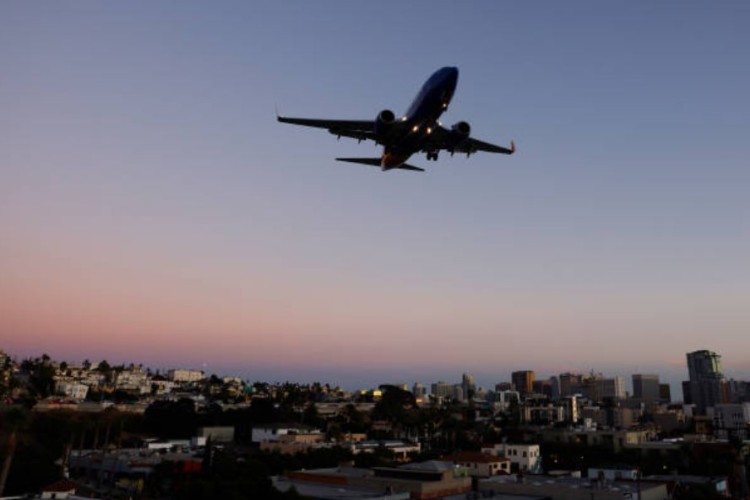
Climate change and aviation industry: By the middle of this century, if nothing changes, aviation’s carbon footprint could derail global climate efforts. Air travel — once the preserve of the wealthy — has become accessible to the masses, and the consequences of this democratisation are profound: soaring carbon emissions, stubborn resistance to real reform, and a dangerous mismatch between policy ambition and technological readiness.
The figures are unsettling. According to the International Air Transport Association, the number of aircraft in the skies will rise from 25,000 today to nearly 40,000 by 2030. Passenger traffic, too, is set to double over the next 20 years. Every new plane in the sky brings with it a heavy environmental toll. Aviation already accounts for about 12% of all transport emissions, and its share is rising. The World Travel & Tourism Council estimates that half of all transport emissions stem from tourism, with flying the biggest contributor.
READ | Pahalgam terror fallout: The cost of the latest India-Pak flashpoint
Planes are responsible for about 2.5% of total global CO₂ emissions — a figure that might seem modest until we remember that aviation’s non-CO₂ effects, such as contrail and cloud formation, have even greater warming potential.
This is not an abstract debate. Climate change is a lived reality. Heatwaves, floods, and fires are disrupting lives and economies. Yet the aviation sector — shielded by its strategic importance and a lack of alternatives for long-distance travel — has been slow to change.
A promising start — but not enough
To be fair, the aviation industry is not entirely in denial. More than 100 countries have signed up to the International Civil Aviation Organisation’s (ICAO) goal of achieving net-zero emissions by 2050. Through initiatives like the Carbon Offsetting and Reduction Scheme for International Aviation (CORSIA), airlines are now required to offset emissions that exceed 2019-2020 levels. If fully implemented, CORSIA could prevent nearly 2.5 billion tonnes of CO₂ emissions over 15 years.
Yet these measures are insufficient. CORSIA, for all its promise, depends heavily on the quality of carbon offsets — a system riddled with loopholes and prone to double-counting. Worse, it only covers international flights, ignoring the massive footprint of domestic aviation.
The real challenge is technological. Sustainable aviation fuels (SAFs) — renewable or waste-derived fuels — can cut emissions by up to 80%. Airlines such as KLM, Lufthansa, and Delta have started using SAFs on select routes. However, SAF production today accounts for less than 1% of global jet fuel consumption. The problem is simple: SAFs are three times more expensive than fossil-based jet fuels. Without large-scale public-private investment and global coordination, SAF will remain a niche solution.
The EDF and other experts argue that promoting SAF without strict sustainability standards could backfire. Poorly managed biofuel expansion could destroy forests and displace food crops, exacerbating global warming rather than mitigating it. Therefore, any transition to SAF must be accompanied by rigorous safeguards on land use and carbon accounting.
Demand management: The elephant in the room
Technology alone cannot solve aviation’s climate problem. Demand-side measures are essential. Here, Europe has taken tentative steps: France has banned domestic flights where trains offer a viable alternative under two-and-a-half hours. Austria has introduced similar restrictions. These efforts are commendable but affect only a tiny fraction of total flights.
Real change will require a combination of strategies: carbon pricing, frequent flyer levies, promotion of rail alternatives, and a cultural shift toward mindful travel. The ICCT estimates that aviation’s emissions could be reduced by 85% by 2050 if all these measures are pursued together.
Traveler choices matter too. Direct flights are better than connecting ones. Economy seats are less carbon-intensive than business class. Short flights should be replaced by train or bus journeys wherever possible. Europe’s revival of night trains — with sleeper routes between Brussels and Berlin, and new offerings from operators like Sunweb — shows that viable, low-carbon alternatives exist for regional travel.
Mitigating climate change: The policy imperative
Aviation’s carbon problem is, fundamentally, a political problem. Governments must create the conditions for change. Incentives for SAF production, research support for electric and hydrogen aircraft, public investment in rail networks, and robust carbon pricing are all necessary.
The UNECE and UNEP have long called for integrated approaches to transport emissions: combining innovative vehicle technologies, smart transport infrastructure, and modal shifts from air to rail and waterways. Transport ministers at successive international forums have emphasised the urgency of action, yet real progress remains patchy and slow.
In the United States, regulatory inertia remains a hurdle. Although the Environmental Protection Agency (EPA) has acknowledged the danger of aviation emissions, it has not yet imposed a strong national CO₂ standard for aircraft. A standard aligned with the Paris Agreement’s goals is urgently needed — not only for domestic flights but to lead global efforts at ICAO.
The aviation industry stands at a crossroads. A business-as-usual trajectory could see its emissions grow by 300% by 2050, wrecking global climate targets. Alternatively, through concerted action, aviation could become a model for decarbonisation — proving that even hard-to-abate sectors can change course.
Success will require honesty: acknowledgment that technology cannot do it alone; courage: willingness to regulate a powerful industry; and solidarity: cooperation across borders, recognising that climate change knows no frontiers.
In the end, the choice is ours. We can either continue flying blind into a climate catastrophe or chart a new, sustainable course for the skies above us. The urgency of the moment leaves no room for delay.
